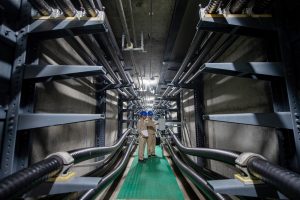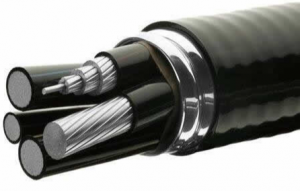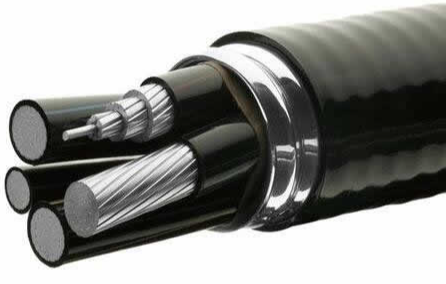What is an armored power cable, and what is a non-armored cable? As commonly used cables, what is the difference between them?
The following ZMS cable editorial gives you a detailed introduction to armored cable and non-armored cable, and what are the differences between them.
Armored cable and non-armored cable
Armored power cable
It is made of different material conductors in a metal sleeve with insulating material, which is processed into a solid combination that can be bent.
The cable armor includes an armored thermocouple, armored RTD, armored heater, and armored lead.
It is mainly used for temperature measurement, signal transmission, and special heating in the chemical industry, metallurgy, machinery manufacturing, power generation and scientific test, etc. The largest amount is an armored thermocouple.
Non-armor cable
It is a cable without a steel armor protection layer.
The insulation performance of the cable is very important to ensure the safe operation of the power supply system, so it is necessary to detect the insulation performance of the cable and find the potential defects of the cable as early as possible.
Most of the current research is focused on armored cables, but few people have studied the insulation testing methods of unarmored cables.
The insulation inspection methods used mainly include the partial discharge method, fiber optic temperature measurement method, leakage current method, etc.

The difference between the armored power cable and unarmored cable
Structure is different
Compared with unarmored cables, cable armoring has an extra layer of metal reinforcement on the surface.
The application scope is different
Armored cable has a reinforcement layer on the surface, which is suitable for use when buried in the ground.
The non-armored cable has no reinforcement layer on the surface. So it can’t be buried underground, but other cases are generally used for non-armored cable.
Different cable use
Armored cable is used when buried in the ground.
And in direct burial as well as laying, it will need to use armored cable.
The non-armored cable can not be used in the burial, but in other cases, the non-armored cable is used.
We will introduce the armor cable in detail below.
Classification of armored cable
Armored is divided into steel belt armored (22,23), fine steel wire armored (32,33), and coarse steel wire armored (42,43).
Steel belt armored cable models are VV22, VVP22, ZRVV22, NH-VV2
Control cable steel belt clad cable, model number KVV22, KVVP2, KVVP22, ZR-KVV22
The steel wire armored power cable, models VV32, YJV32, ZR-VV32
Steel wire armored control cable Model No. KVV32 KVVP32
Armored communication cable model HYA53, HYAT53, HYA23, HYV22, HYA22 (rat-proof, buried)
Armored cable model meaning
Steel belt armored cable
To enable the cable to withstand radial pressure, it adopts a double steel belt and gap wrapping process, which is called steel belt armored cable. The steel belt is then wrapped around the cable core and the plastic sheath is extruded.
This type of cable model is expressed as control cable KVV22, plastic force cable VV22, communication cable SYV22, etc. The two Arabic numerals in the subscript of this kind of cable model. The first “2” indicates a double steel belt armored.
The second “2” indicates polyvinyl chloride sheathing, such as polyethylene sheathing to “2” to “3” can.
This type of cable is generally used mainly on occasion, as the bearing pressure is relatively large.
For example: through the highway, square, and vibration is relatively large roadside, railroad side, etc. Suitable for buried, tunnel, and through-the-pipe laying.
The steel wire armored cable
For the cable to withstand large axial tension, it adopts multiple low-carbon steel wire wrapping processes, which are called steel wire armored cables.
After the cable is formed, the wire is wrapped around the core at the necessary pitch and then extruded to the sheath.
This kind of cable model in the representation such as control cable KVV32, plastic force cable VV32, coaxial cable HOL33, etc.
Two Arabic numerals in the model, the first “3” means fine steel wire armor.
The second “2” indicates polyvinyl chloride sheathing, and “3” indicates polyethylene sheathing.
This type of cable is generally used in applications with large spans and large laying drops.

The advantages of armored cable
1 Armored cable mechanical protection layer can be added to any structure of the cable to increase the mechanical strength of the cable and improve the corrosion resistance.
Specially designed for areas that are vulnerable to mechanical damage and highly susceptible to erosion.
It can be laid in any way, among which steel belt gauntlet cable is generally laid flat and can withstand external forces in the horizontal direction.
The steel wire armored cable is mostly used in vertical installation places such as vertical shafts.
2 Cable with an armored layer can also enhance mechanical protection such as tensile and compressive resistance and prolong service life.
3 The armored cable has a certain resistance to external force and also prevents rat bite, which will not cause power transmission problems through the armored.
The bending radius of the armored should be large, and the armored layer can be directly grounded to protect the cable.
When to use an armored cable?
1 Armored cable is generally a fixed power cable.
Generally, it is fixed in one place, basically not moving, and the power cable transmits electric power.
2 Suitable for underground direct burial.
It can make armor-able cable directly buried without pipe, and it is inexpensive and good for direct burial in rocky areas.
3 Armored cable is suitable for roads, roadside, residential areas, parking lots, pedestrian streets, and other places with high pressure.
4 The purpose of adding an armor layer in the cable is not only to enhance mechanical protection such as tensile strength and compressive strength, but also to improve the anti-interference performance of the cable through shielding protection.
5 Commonly used armor materials are steel belts, steel wire, aluminum belts, aluminum tubes, and so on.
Among them, steel belts and steel wire armor layers have high magnetic permeability and a good magnetic shielding effect, which can be used to resist low-frequency interference.
6 The mechanical protection layer of armor cables can be added to any structure of the cable to increase the mechanical strength of the cable and improve the corrosion resistance.
This is a kind of wire and cable designed for areas susceptible to mechanical damage and corrosion.
The above is a detailed introduction to armored power cables.
